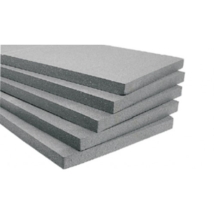Expande Polistren Sert Köpük (EPS – Genleştirilmiş Polistren) köpük halindeki, termoplastik, kapalı gözenekli tipik olarak beyaz renkli bir ısı yalıtım malzemesidir.
Polistren taneciklerinin şişirilmesi ve birbirine kaynaşması ile elde edilen EPS (Genleştirilmiş Polistren sert köpük) ürünlerde, taneciklerin şişirilmesi ve köpük elde edilmesi için kullanılan şişiricigaz “Pentan” dır. Pentan tanecikler içinde çok sayıda küçük gözeneklerin oluşmasını sağladıktan sonra üretim sırasında ve üretimi takiben çok kısa sürede hava ile yerdeğiştirir. Böylece EPS levhaların bünyesinde bulunan çok sayıda (1m3 EPS’de 3-6 milyar) küçücük kapalı gözenekli hücreler içinde durgun hava hapsolur. Malzemenin % 98’i hareketsiz ve kuru havadır.
EPS VE ÇEVRE
YANLIŞ : EPS kullanımı Ozon Tabakası için tehlikelidir.
DOĞRU : EPS’nin etkin bir yalıtım malzemesi ve hafif bir ambalaj olarak kullanılması bu etkiyi yaratan gazların üretimini azaltır.
YANLIŞ : EPS kullanımı “Küresel Isınma”ya ve “Sera Etkisi”ne yol açar.
DOĞRU : EPS zararlı gazlar içermediğinden “Küresel Isınma”ya ve “Sera Etkisi”ne yol açmaz. Sera etkisi gazları olarak isimlendirilen su buharı, karbondioksit ve ozon gibi gazlar kısa dalga radyasyonların geçişine izin verirler fakat uzun dalga radyasyonları absorbe ederler. Güneş ışınları da dünyaya kısa dalga radyasyonu olarak gelir ve dünyayı ısıtır. Bu ısı uzun dalga radyasyonu olarak ortaya çıkar. Bu da bahçelerdeki sera mekanizmasına benzediği için “sera etkisi” olarak adlandırılır. Bu etki olmasa idi dünya ısısı – 30°C civarında olacaktı.
Günümüzde ise bu gazların aşırı artması nedeniyle dünyamız “aşırı ısınma” tehlikesi ile karşı karşıyadır. Bu etkiyi oluşturan gazlar arasında karbondioksit en büyük paya sahiptir. Karbondioksit yayılmasının %80’i de fosil kökenli yakacakların yanmasından oluşmaktadır. Bu durumda EPS ısı yalıtımını sağlayıp, yakıt tasarrufu sağladığı için olumlu bir etkiye sahiptir.
YANLIŞ : EPS atıkları tekrar kullanılamaz.
DOĞRU : EPS yeniden kullanılabilir, geriye dönüşümlüdür ve enerji kaynağı olarak değerlendirilebilir.
EPS atıkları çeşitli işlemlerden sonra tekrar üretimde kullanılabilir. Buna ek olarak EPS ambalajların bir çoğu da ilk kullanımdan sonra tüm özelliklerini korumaları sayesinde tekrar kullanılabilir. EPS atıkların öğütülerek toprağın geliştirilmesi için drenaj ve havalandırma amacıyla kullanılmaları da mümkündür.
EPS’nin diğer atıklar arasında kolayca farkedilebilir olması da geridönüşümünü kolaylaştırmaktadır.
YANLIŞ : EPS ambalajlar çok büyük oranda çöp yaratmaktadır.
DOĞRU : EPS tüm çöplerin ağırlığının binde birini (% 0,1) oluşturmaktadır.
EPS ambalajların büyük çoğunluğu belediye atıklarına gider. Bu atıklar evler ve ofislerden kaynaklanır. Avrupa’da yapılan ölçümlerde belediye atıklarının tüm atıkların %5’ini oluşturduğu, geri kalan kısmın tarımsal ve maden artıkları olduğu saptanmıştır. Belediye atıklarının %7’si plastik malzemelerdir. Bunların da %1,5’u EPS’dir.
YANLIŞ : EPS üretimi dünya kaynaklarının hatalı ve aşırı kullanımına yol açar.
DOĞRU : Bir hammaddenin çevre üzerindeki etkisinin gerçek bir resmini görebilmek için onun “beşikten-mezara” tüm aşamalarını incelemek gerekir. Bu açıdan bakıldığında EPS, diğer malzemelere kıyasla dünya kaynaklarının en verimli kullanımıdır.
EPS diğer malzemelerle kıyaslandığında, üretimi için ve daha sonra kullanımında harcanan kaynak miktarı çok daha azdır. Üretimi için gerekli enerji, su ve diğer malzemelerin oranı EPS’nin alternatifi malzemeleri üretmek için gerekenlerden daha azdır. Buna ek olarak EPS’nini yalıtım amacıyla kullanılması büyük enerji tasaruflarının yapılmasını, dolayısıyla dünya kaynaklarının daha ekonomik harcanmasını sağlar.



